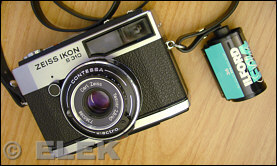Zeiss Ikon Contessa S 310

|
|
|
| Style, film format | Zone-focus compact aperture-priority automatic-exposure |
|
|
|
| Lens, shutter | 40mm f/2.8 Tessar, Prontor 500S electronic shutter |
|
|
|
| Photo quality | Very good |
|
|
|
| Ergonomics | Very easy to use |
|
|
|
This is the last model to carry the famed Contessa name for Zeiss Ikon. The Contessa S 310 was released in the early 1970s.
The camera used the classic Tessar lens mated with a Prontor 500 S electronic shutter. The camera offers aperture-priority automatic exposure.
The S 310 is quite diminutive and packs a considerable amount of features into it. There is a small indicator on the back of the camera that lets the user know if the film has been loaded properly. The film rewind crank is on the bottom, as is the small tab that unlocks the back, which slides off the camera in typical German tradition.
The viewfinder provides a wealth of information, including selected aperture, shutter speed and pictograms that represent the distance to the subject: one person, two people and mountain. It's entirely possible to do everything you need without taking your eye from the viewfinder. There are no parallax indicators in the viewfinder, so you'll have to compensate when shooting closeups.
The camera is powered by four 1.5-volt PX625 batteries. That in itself is unusual, but further investigation reveals that it actually is two sets of batteries connected in parallel. So the camera really requires just 3 volts, and it's simple enough to convert the camera to accept a more common 123 lithium cell, which provides plenty of current and for a long time.
The camera in many ways parallels the features offered on the Rollei 35 cameras, while offering an ease of use that surpasses the Rollei. The Tessar lens is plenty sharp at f/8 and smaller. Photos taken at larger apertures show a touch of softness and vignetting. In general, however, the camera, its lens and the photos have a lot of personality.
The body is very solid and has heft to it. I've found that the exposure system is right on in most cases, though it's tricked in the usual backlit situations or where the background is very light or dark. There is no exposure compensation button, although you can always change the film-speed setting in lieu of that.
Overall, it's a nice little camera with a unique place in Zeiss Ikon's history.
